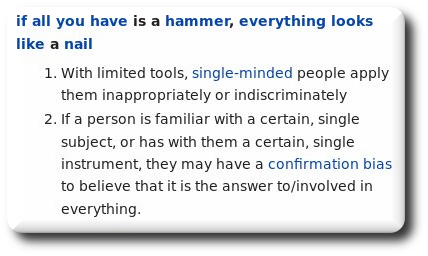
 Reference: "If all you have is a hammer, everything looks like a nail"
Reference: "If all you have is a hammer, everything looks like a nail"
THE following thoughts and corresponding articles are about the US, but lessons from these are equally applicable to the EPO, where the quality of patents is totally out of control (number of patents granted allegedly rose 40% in just one year!).
"We have been writing about a vicious war between the interests of law firms and the interests of the industry at large -- something which in Europe culminates in the battle over UPC."In the eye of a patent lawyer, more patents mean more business and more business means more personal wealth (for the lawyer at least). But at whose expense? Where does the capital come from and and where is the value creation, so to speak? We have been writing about a vicious war between the interests of law firms and the interests of the industry at large -- something which in Europe culminates in the battle over UPC.
Is overpatenting desirable?
Are many disputes desirable?
"Granting lots of crappy patents does not make one a "powerhouse" but a fool who serves the patent microcosm."How about lawsuits, injunctions, patent thickets and the monopolies these tend to guard?
Yesterday we found this new article titled "The surprising rise of China as IP powerhouse" -- an article which for the most part admires China's patent bubble. This whole article is a colossal mess and quite bluntly nonsensical. Granting lots of crappy patents does not make one a "powerhouse" but a fool who serves the patent microcosm. The only reason the patent microcosm in the West keeps mentioning China -- a retreat or reduction of all arguments to just "China!" [1, 2] (the talking point about China is that it grants a lot of patents and is hence "leading") -- is that it envies the future of Chinese patent lawyers, even if this vision dooms China'a large producing industry.
The notion that companies need to stockpile patents is typically promoted by people whose occupation is just that. They try to justify their own existence and rationalise their never-ending salary (from companies that create dedicated, in-house 'IP' departments). Uber, which was recently sued by Google, must be foolish enough (or misinformed) to believe that stockpiling patents by purchasing is a good idea, but watch what IAM wrote yesterday. Incredible! What can they possibly do? Sue Google in retaliation? Nobody would win in such endless litigation battles except law firms, as usual.
"The notion that companies need to stockpile patents is typically promoted by people whose occupation is just that."Following AIA the United States went from attempting to maximise patents and litigation to trying to reduce them. This means invalidating in bulk a lot of existing (previously granted) patents and discouraging litigation, primarily but not limited to troll litigation. Suffice to say, the patent 'industry' is up in arms over it. It spreads malicious (and false) rumours about officials who are responsible for it, it creates "task forces" to lobby, it misleads politicians about it and maybe pays (bribes) some of them too.
Just watch last night's Patently-O links from Anthony McCain, half of which were about PTAB, which Patently-O is trying to slow down in spite of steady and healthy growth (covered here last night). PTAB is reducing the number of patents by crushing the bad ones and setting an example. Who could possibly object to that?
"The more patents PTAB invalidates, the better. But the way the patent 'industry' sees it is warped by its greed (desire for money, not science/advancement), which necessitates more and more patents."Watchtroll, which habitually attacks PTAB, is cited as saying that the rules need to be changed, making PTAB a lot less effective. It's being masked as "improvement" (to quote: "By adopting these improvements to the IPR process the system will become fairer, afford patent owners more due process, and protect patent owners from harassment and hardship while still fulfilling the statutory mandate to provide an alternative forum for administrative resolution of validity challenges."), but it's actually the very opposite of improvement. The Shire case, a famous PTAB case, is recalled in another blog of the patent microcosm and the USPTO is then accused of misleading about PTAB numbers, as if PTAB's justice should be measured by the percentage of cases affirmed or reversed (PTAB is usually petitioned to look into already-dubious patents, so reversals, i.e. invalidations, are to be expected). To quote:
Currently, the USPTO measures decision outcomes of ex parte appeals in three different ways: affirmed, affirmed-in-part, or reversed. This is highlighted by the USPTO’s recently released statistics on outcomes of ex parte appeals for FY2017. These stats show that the Patent Trial and Appeal Board (PTAB) very frequently upholds Examiners on appeal, with a 55% affirmance rate. This rate is consistent with previous years’ affirmance rates. These affirmed rates suggest a job “well done” by the USPTO. However, the way the USPTO counts affirmances yields counterintuitive and misleading results, especially with cases involving multiple grounds of rejection. Indeed for accountability purposes, this way of measuring appeals cloaks the USPTO’s Examining Corps failures.